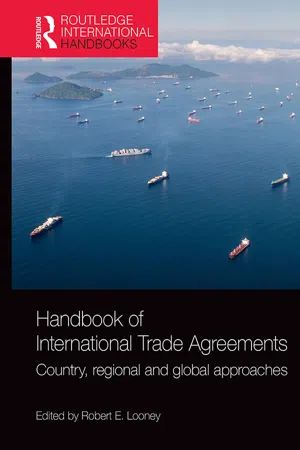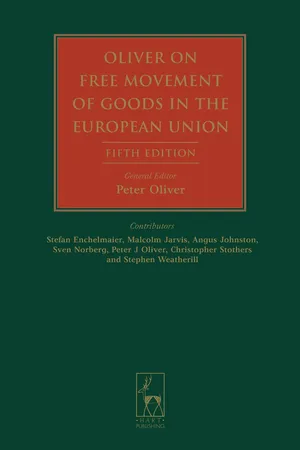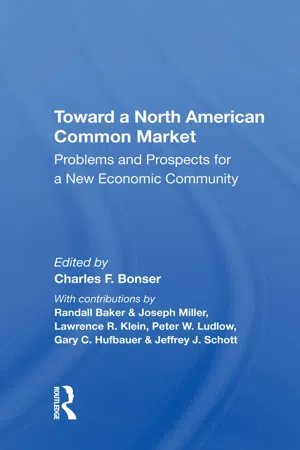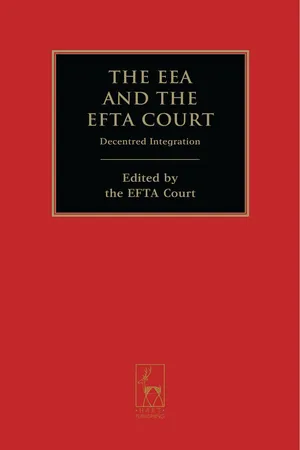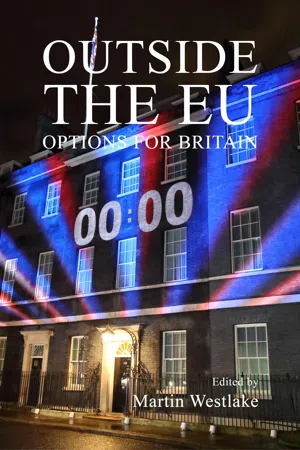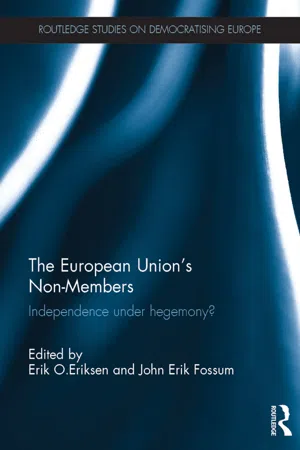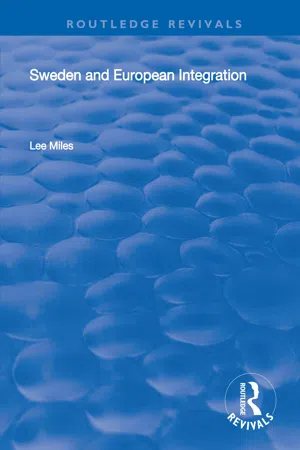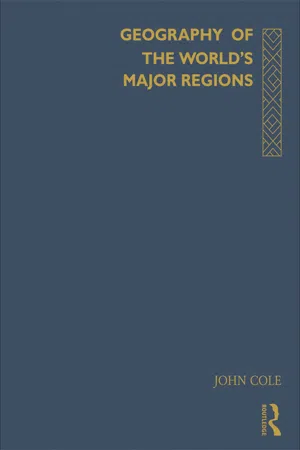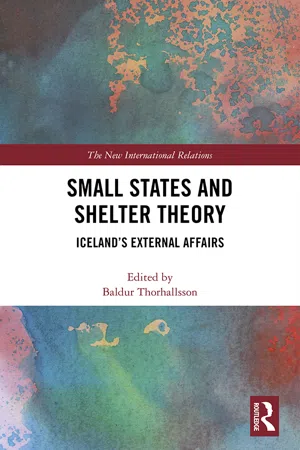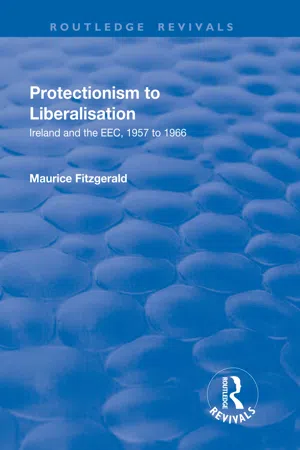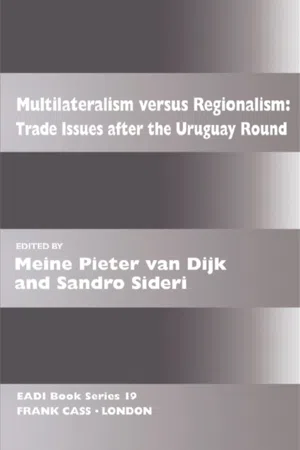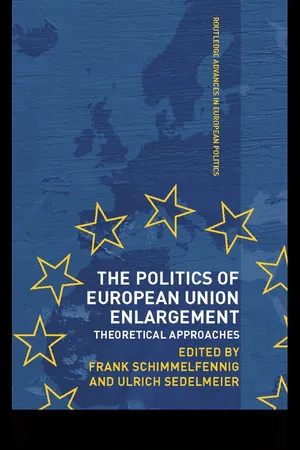History
European Free Trade Association EFTA
The European Free Trade Association (EFTA) is an intergovernmental organization established in 1960 to promote free trade and economic cooperation among its member states. EFTA's founding members were Austria, Denmark, Norway, Portugal, Sweden, Switzerland, and the United Kingdom. EFTA operates in parallel with the European Union and has developed free trade agreements with various countries and regions around the world.
Written by Perlego with AI-assistance
Related key terms
12 Key excerpts on "European Free Trade Association EFTA"
- eBook - ePub
Handbook of International Trade Agreements
Country, regional and global approaches
- Robert E. Looney, Robert E. Looney(Authors)
- 2018(Publication Date)
- Routledge(Publisher)
24EFTA
Marius Vahl and Aslak Berg1Introduction
The European Free Trade Association (EFTA) was set up in 1960 to promote free trade and closer economic cooperation among its members. Since its establishment, EFTA has changed considerably, both in terms of its membership and with regard to the main tasks it performs for its member states.Originally comprising seven countries, EFTA currently has four member states: Iceland, Liechtenstein, Norway and Switzerland. All are relatively small, advanced and open economies that are dependent on trade for their prosperity. They share generally liberal approaches to trade, while being highly protective of their agricultural sectors. In comparison with other regional trade associations, EFTA is unusual in that its four member states do relatively little trade with each other. Thus, in 2016 intra-EFTA trade only constituted 0.55 per cent of EFTA’s global trade in goods. The rationale for EFTA can therefore not be found in the depth of trade ties between its member states, but rather in historical developments and the continued utility of EFTA for managing their trade relations.Although intra-EFTA trade remains important in absolute terms, in practice EFTA’s main purpose today is to facilitate joint cooperation with third countries. While intra-EFTA relations used to dominate its agenda at the outset, now EFTA’s principal activities are to manage trade and economic relations with the European Union (EU) through the Agreement on the European Economic Area (EEA), and the negotiation and management of free trade agreements (FTAs) with partners across the globe.EFTA has a dual structure. The EFTA Convention, which regulates trade and the free movement of persons between the member states, and negotiations and trade relations with non-EU countries, are managed from EFTA’s headquarters in Geneva on behalf of all EFTA states (referred to as ‘EFTA at four’). The EEA Agreement, through which three EFTA states – Iceland, Liechtenstein and Norway (the EEA EFTA states2 - eBook - ePub
- Peter J Oliver(Author)
- 2010(Publication Date)
- Hart Publishing(Publisher)
14 The European Economic Area I. Introduction 14.01 Relations between the EU and its trading partners in Western Europe have always been the source of the utmost interest to both sides. The reason is simple: the two groups conduct a major part of their external trade with one another. In 1960 the Convention establishing the European Free Trade Association was signed by seven countries which at that time could not, or did not wish to, join the Community, namely: Austria, Denmark, Norway, Portugal, Sweden, Switzerland and the United Kingdom. The Convention came into force in the same year. Initially, Finland was prevented by its delicate relationship with the Soviet Union from seeking full membership, so that it was only as from 1 January 1986 that Finland became a full member of EFTA. However, by virtue of the 1961 Finland–EFTA Agreement, it did for all practical purposes acquire this status much earlier. Iceland joined in 1970. In 1973 Denmark and the United Kingdom left EFTA to join the Community. This prompted the EEC to conclude a series of almost identical Free Trade Agreements (the first of their kind) with each of the remaining EFTA countries, namely: Austria, Finland, Iceland, Norway (which had just rejected accession to the Community in a referendum), Portugal, Sweden and Switzerland. 1 No treaty could be concluded with EFTA as such, since that organisation has no treaty making powers and no legal personality. These agreements, which came into force on various dates in 1973 and 1974, were supplemented by a tripartite Agreement between the EEC, Switzerland and Liechtenstein, 2 which extended the provisions of the EEC–Switzerland Agreement to the Principality. Liechtenstein was not then a member of EFTA but the EFTA Convention was applicable to it due to its customs union of 1923 with Switzerland, and a special Liechtenstein Protocol under which Switzerland represented its interests in EFTA. Liechtenstein became a member of EFTA only in 1991 - eBook - ePub
Toward A North American Common Market
Problems And Prospects For A New Economic Community
- Charles F Bonser(Author)
- 2019(Publication Date)
- Routledge(Publisher)
The EFTA balance sheet is in almost every respect, therefore, very positive. Yet EFTA collectively and its member states individually have for much of the 30 years since the association was founded displayed profound anxiety. This anxiety has persisted despite a series of agreements with the EC from the 1960s onward which have in many ways been remarkably generous. Given the widespread hope amongst the original Six that Britain would eventually become a member of the Community, the Six's desire to maintain good relations with EFTA in the initial, British period were perhaps hardly surprising. This general goodwill continued, however, after the defection of the British and the Danes. The Community did not, it is true, treat the EFTA as such at this point, but the Free Trade Agreements with all EFTA members that were concluded in the early 1970s were virtually identical. They provided for complete free trade in industrial and processed agricultural products within a period of less than ten years. Primary agricultural products and fisheries were excluded. Joint committees were established to administer the agreements.In 1984, the two sides went further. Following a joint ministerial meeting between EC and all the EFTA governments at Luxembourg on April 9, 1984, at which, to quote the final declaration, they "took stock of more than a decade of cooperation and free trade and laid down orientations to continue, deepen and extend cooperation within the framework of and beyond the Free Trade Agreements," the ministers decided to work together to transform what was already, in their own words, "the largest system of free trade in the world within which one quarter of world trade took place" into a "dynamic European economic space."More specifically, they agreed to tackle the new generation of trade policy questions: standards, technical barriers, border facilities, rules of origin, unfair trade practices, state aids, and access to government procurement. They also agreed to broaden and deepen cooperation in research and development, with particular emphasis being placed on industrial and technological fields of the future, "such as telecommunications, information systems and the new audiovisual media." Cooperation and consultation were to be extended too to transport, agriculture, fisheries and energy, working conditions, social protection, culture, consumer protection, the environment, tourism, and intellectual property. They would also work together in multilateral fora such as the OECD, Gatt, IMF and the World Bank. - eBook - ePub
The EEA and the EFTA Court
Decentred Integration
- EFTA Court(Author)
- 2014(Publication Date)
- Hart Publishing(Publisher)
Because of this two-pillar system, the EEA has few common bodies responsible for all Contracting Parties together. The central institution in this respect is the EEA Joint Committee. The Agreement gives it the legislative and executive powers to implement and operate it. Unlike other multilateral treaties, decisions are taken not by all the Contracting Parties but by agreement between the EU on the one hand and the EEA EFTA States, ‘speaking with one voice’, on the other. This can be explained by the history of the origin of the Agreement.II. HISTORICAL BACKGROUND
When the internal market of the EU took shape in the second half of the 1980s, the then seven EFTA States absolutely wanted to be associated with it in one way or another. They had understood that the EU—or European Communities, as the EU was then called—would definitely be the crystal nucleus for further European integration and that it was vital for their economies to participate in the so-called ‘four freedoms’. For the Community also there was a strong interest to get the EFTA States on board, as they were by far their biggest trading partners at the time.After some years of preliminary talks and analysis of different options to bring the two sides together, the speech of the then President of the Commission of the European Communities, Jacques Delors, before the European Parliament on 17 January 1989 was the starting signal for concrete exploratory talks and negotiations towards a comprehensive association agreement.He had already given a rough sketch of what would become the EEA, with an institutional vision of two pillars—the European Communities and EFTA—forming together common decisional and administrative organs. This presupposed major changes for EFTA, which had been a pure intergovernmental free-trade organisation since its beginnings in 1960. It would have to accept a certain ‘supranational spirit’ and build impartial institutions ‘policing’ the internal market.Two issues then dominated the negotiations from 1989 up to the signature in 1992. The first was the extent to which the EFTA States would take over the internal market acquis of the Community (plus other policies) and how far specific exceptions on the acquis - eBook - ePub
Outside the EU
Options for Britain
- Martin Westlake, Martin Westlake, Martin Westlake(Authors)
- 2020(Publication Date)
- Agenda Publishing(Publisher)
4 hopping from the smaller EFTA pillar to the already much larger EU one. The asymmetry between the two pillars became even more evident. Then, in 2004, ten new mainly central European countries joined the EU, followed a few years later by Bulgaria and Romania (2007) and, more recently, Croatia (2013), further expanding the EU pillar.There are people in the EFTA states who support the UK joining, or more correctly rejoining, EFTA, and then also rejoining the EEA.5 They would welcome a beefing up of the EFTA pillar and a dilution of Norway’s dominance of it. What better way to do this than by getting a wealthy G7 economy with nearly 70 million inhabitants to hop across to the other side? There are others, however, who feel that the UK could destroy the EEA. Especially from Norway, although they are not alone, the opinion is voiced that the UK is too big for the EFTA pillar in the EEA, and that because the good functioning of the Agreement depends so much on consensus decision-making, these same voices feel it is not well suited to a country that is prone to an “exceptionalist” way of thinking.The EEA Agreement was not envisaged by all involved in its construction as a permanent fixture in the European economic and political landscape. Some viewed it as a temporary waiting and preparatory space for countries entering into the EU. The fact that it has survived for so long is, again, a testament to the ingenuity of its construction and adaptability.THE FOUR FREEDOMSA central objective of the EEA Agreement is to extend the internal market to the EEA EFTA states. Free movement of goods, services, persons and capital is extended to Iceland, Liechtenstein and Norway. In order to enable this to happen, and for there to be a level playing field between the EFTA countries and the EU member states, the three EFTA countries consent to incorporate EU internal market legislation into national law. They agree to do this unanimously, via JCDs between the EEA EFTA states and the EU, within the two-pillar structure mentioned above. In 2019, for example, the EEA Joint Committee met eight times and adopted 319 decisions incorporating 708 legal acts. Since it came into force in 1994, more than 11,000 legal acts have been incorporated into the EEA Agreement and implemented into Norwegian law. About half of these remain in force today. - eBook - ePub
The European Union's Non-Members
Independence under hegemony?
- Erik Oddvar Eriksen, John Erik Fossum, Erik Oddvar Eriksen, John Erik Fossum(Authors)
- 2015(Publication Date)
- Routledge(Publisher)
However, the final institutional set-up of the EEA with its ‘participatory deficit’ was a source of frustration for the EFTA countries (Gstöhl 1994). In 1995, Austria, Finland and Sweden joined the EU, while Norway, for the second time, failed to accede because of a negative referendum. Switzerland suspended its application after the failure to ratify the EEA Agreement in 1992. This has left Iceland, Norway and Liechtenstein as EEA EFTA states. Subsequently, Switzerland built up its ‘stake’ in the internal market step by step by concluding bilateral sectoral agreements in addition to its 1972 free trade agreement (FTA) with the EC. This bilateral approach has come to stand as the second route of integration with the EU. Although this policy has in substance been approaching the contents of the EEA Agreement, it lacks an overarching structure, and ‘there is less institutionalised political dialogue between the EU and Switzerland than between the EU and most other third countries’ (Vahl and Grolimund 2006 : 112). A different approach was taken by Andorra, San Marino and Turkey which in the 1990s entered the EU’s customs union based on bilateral agreements. They acquired ‘a stake’ in the internal market in exchange for the implementation of the relevant acquis. Since 1963 Turkey holds an association agreement with the EU and opened accession negotiations in 2005, whereas Andorra and San Marino have concluded additional bilateral cooperation and monetary agreements with the EU and in recent years called for deeper relations - eBook - ePub
- Lee Miles(Author)
- 2019(Publication Date)
- Routledge(Publisher)
Formal EC-EFTA Negotiations (June 1990-March 1993). These talks were continually delayed. A number of areas of dispute appeared - most notably, derogations from the Community’s ‘acquis’ (at least initially); arrangements on Fish, Transit and the creation of an EEA Cohesion Fund; the nature of the EEA’s institutional arrangements (especially the level of EFTA influence on EC decisions i.e. ‘decision-shaping’ or ‘decision-making’) and the EEA’s legal apparatus. The European Court of Justice formally objected to the role of any EEA Court between December 1991-April 1992. Even when the EEA agreement was finalised, the fiasco did not end. On 6 December 1992, the ratification procedure (by all 19 relevant parliaments) was de-railed by the Swiss people’s rejection of the EEA in a referendum, leading to parts of the agreement having to be renegotiated to take account of Switzerland’s exclusion. The agreement was eventually signed in Oporto (2 May 1992) and came into force a year later than the SEM (1 January 1994).Swedish Frustration with the EEA: Moving out of the Slow Lane
At face value, the advantages of the EEA for all the EFTA countries was clear to see. The EEA would ‘create a single market in Western Europe: a market of some 380 million’51 and in practice, would extend the majority of the SEM programme to cover the EFTA countries. It established ‘a dynamic and homogeneous integrated structure based on common rules and equal conditions for competition’ and even more significantly, was ‘intended to give fresh impetus to the privileged relationship’ between the Community and the EFTA countries.52 Indeed, the signed copy of the EEA agreement contained 13 different languages, some 15,000 pages and weighed around 100 kgs.53 However, this did not mean the complete adoption of the four freedoms by the EFTA countries, but merely the fullest possible realisation of them and crucially the establishment of an advanced free trade area, rather than a full customs union. The EEA agreement also had several major exceptions to free trade and did not, for the most part, include agriculture. None the less, the EEA was a comprehensive agreement. It went ‘beyond purely economic cooperation and also covers areas of more direct interest to the public’.54 It included ‘flanking and horizontal policies’ incorporating the environment, research and development, education, social and consumer policies and a sophisticated institutional structure to administer the EEA.The Swedish position regarding the development of the EEA was twofold. On the one hand, the Carlsson government had ‘first and foremost chosen to manage relations with the European Community in an EFTA-context ... Sweden has opted for a broad approach to West European integration’.55 - eBook - ePub
- John Cole(Author)
- 2003(Publication Date)
- Routledge(Publisher)
Although almost two-thirds of the area and half the population of Europe is in Central Europe and the former USSR, the supranational units of Western Europe, the EU and EFTA, have appropriated the name of the continent for themselves. From a geographical point of view as much as from economic and political ones, the EU and EFTA countries must be considered both as Member States of their groups and as individual countries. It should, however, be appreciated that in spite of four decades during which the countries which first joined the EU have renounced part of their sovereignty to supranational bodies, the individual Member States are still very much alive, as are many regions within them, such as Scotland in the UK and Catalonia in Spain. The limited extent of the political powers of the institutions of the EU is reflected in the fact that its budget is equivalent to no more than about 1 per cent of the total GDP of the EU or 3 per cent of the combined budgets of the EU Member States. The EFTA countries have been even less strongly bound together, their association being primarily economic. Until the 1990s, on the other hand, all the countries of Central Europe apart from Yugoslavia and Albania were tied politically, economically and militarily to the Soviet bloc and the CMEA. They are now changing in the opposite direction to the EU countries.FIGURE 5.2 The territorial growth of the EU showing its changing shape. The outer lines join extremities of the EU space. The shading on the lower right-hand map indicates the duration of membershipDuring the Second World War, Germany briefly occupied and organised much of Europe for its own purposes. For a time France, Italy, the Netherlands, Belgium and Luxembourg were drawn into the German war orbit against their wishes. Those same countries later voluntarily became the founding members of the European Coal and Steel Community (ECSC) in 1952 and of the European Economic Community (EEC) and the European Atomic Energy Community (EAEC or Euratom) in 1958. To counterbalance the EEC, EFTA was established in 1960. Subsequently, six additional countries joined the EEC—three of them, the UK, Denmark and Portugal, defecting from EFTA to do so—while in 1990 East Germany (the former communist GDR) was absorbed. Table 5.3 gives key dates in the development of the EU and Figure 5.2 shows its territorial expansion. One of the main reasons for creating and developing the EU was the fact that trade between the countries of Western Europe has grown enormously since the Second World War. Thus an economic reason rather than a strategic one for joining the EEC is shown by the data in Table 5.4 - eBook - ePub
Small States and Shelter Theory
Iceland's External Affairs
- Baldur Thorhallsson, Baldur Thorhallsson(Authors)
- 2018(Publication Date)
- Routledge(Publisher)
Governmental and academic reports, which have been commissioned to examine the cost and benefits of the EEA membership of Iceland and Iceland’s position in the European integration process, indicate that the country is provided with important economic shelter by the EEA Agreement in terms of our shelter theory. This was the outcome of a report published by the Institute of International Affairs at the University of Iceland in 2014 and another report published by the prime ministerial office (Office of the Icelandic Prime Minister 2007). Also, examples of the benefits enjoyed by Iceland under the EEA Agreement were already listed in a report on Iceland’s position in European cooperation published by the Ministry for Foreign Affairs in 2000. These include: improved market access; a greater role for Iceland in European cooperative projects, particularly in research and development; a greater influx of capital into the economy; a greater harmonization of economic and commercial legislation; increased liberalization; and a stimulus in the direction of more modern administrative practices. According to the report, the EEA Agreement has given Iceland access to those elements which benefit it most, while simultaneously permitting the nation to recuse itself from aspects of European cooperation which are not beneficial (Icelandic Ministry for Foreign Affairs 2000, 7–12). The report also states that non-participation in the EU’s trade puts Iceland in an advantageous position, since it has not been involved in the trade disputes which have arisen between the EU and third countries, notably the US and Japan.Taken as a whole, the EU and the EFTA member states are by far Iceland’s most important trading partner. In 2015, 78.1 per cent of total Icelandic export of goods went to the EEA and 60.7 per cent of Icelandic total import of goods came from the European market (Icelandic Statistics 2016a, 21). This shows how important the single market is for Iceland’s foreign trade. Its exports to the EU consist mainly of fish and fisheries products. Iceland is the fourth largest exporter of fish and fisheries products to the EU after Norway, China, and Ecuador in terms of value. In 2013, Iceland’s exports totalled more than €945 million, or 5.4 per cent of all EU fish imports (European Commission 2017a). In addition, EFTA has made free trade agreements on behalf of its members covering 38 countries (EFTA n.d. a), see Figure 6.1 in the preceding chapter. Also, the EFTA states have concluded so-called Joint Declarations on Cooperation with a number of states which are often the first step towards free trade relations (EFTA n.d. b) (see discussions in Chapter 6 and Figure 6.2 - eBook - ePub
Protectionism to Liberalisation
Ireland and the EEC, 1957 to 1966
- Maurice Fitzgerald(Author)
- 2018(Publication Date)
- Routledge(Publisher)
Firstly, because the earlier FTA negotiations had been on the basis of a seventeen-nation OEEC, the course of those discussions had attempted to associate all members ‘in a movement to free trade and cooperate in economic matters on a multilateral, seventeen-country basis’. In 1959, however, the negotiations for an FTA were now going to be between two separate groups of countries, in addition to a number of individual countries which would be, it was presumed, ‘unlikely’ to result in a seventeen-nation organisation of the ‘old pattern’. Secondly, because of their ‘form and purpose’, the OEEC-sponsored FTA negotiations had placed the peripherals in a powerful position to block or veto wider progress if their individual demands were not met. The peripherals would not enjoy such a position in the new negotiations that were now to follow, as they would not take place under OEEC auspices and because the peripherals would have no direct role to play in them anyway. 106 This assessment of the difficulties created by the presence of non-members of both the EEC and the EFTA within any negotiations scenario contended that the peripherals problems would, in fact, now be three-fold. The reasons for this situation were listed as follows: the existence of two European economic groupings ‘each engaged in reducing tariff and quota barriers within the group, but neither extending benefits of these reductions to outsiders’; ‘the expectation which Greece and Turkey had formed during the former F.T.A. negotiations (and will have retained) that the new organisation would supply them with financial assistance to develop their economies. Ireland and Iceland are to a lesser extent interested in development capital, but if Spain joined this group she would be a candidate on par with Greece and Turkey’; ‘their desire to be associated as equals with the other members of any all-European economic association... associated with the institutions of neither the E.E.C - eBook - ePub
Multilateralism Versus Regionalism
Trade Issues after the Uruguay Round
- Meine Pieter van Dijk(Author)
- 2005(Publication Date)
- Routledge(Publisher)
The EFTA states have agreed to take over Union arrangements which provide for the free movement of workers, the right of establishment, mutual recognition of diplomas and social security. These arrangements apply only to citizens. Hence, they will not necessarily affect the rights of migrant workers or visitors from third parties. Nonetheless, to the extent that they are accompanied by the removal of police controls at frontiers, the effect will be similar to that of the SEM. In other words, movement between countries will tend to be easier but there may be offsetting reinforcements to the external barriers to the movement of people.Horizontal and Flanking Policies
The EEA agreement covers some areas of co-operation outside the four freedoms. In some cases, these may have implications for developing countries. For example, the EFTA states will participate in the implementation of the EU’s Third Framework Programme of Union activities in the fields of research and technological development. There is scope for third parties to participate as members of the research consortia active within these programmes. The Third Framework Programme specifies that, subject to certain conditions, programmes are open to interested parties in non-member states with which the Union has concluded economic and technical co-operation agreements. These include most developing countries.The Enlargement of the EU
The EEA has been seen by all parties as a precursor of accession to the EU by the EFTA states, although this is not certain to occur. The potential implications for third parties of a new, ‘northern’ enlargement of the EU would be greater than those of the EEA, but probably less substantial than the SEM given the relatively small size of the EFTA markets. The total gross domestic product (GDP) of EFTA (minus Switzerland) in 1991 was US$639.5 billion compared to the US$6,251.7 billion of the EU, or about ten per cent.There are three main ways in which a northern enlargement might affect third parties for good or ill. The actual impact will depend not only on the way in which EFTA and EU policies change to take account of the enlargement but also on the characteristics of the third party. According to their production and export situation some states may tend to benefit, some to lose, and some to do both in relation to different products from the same changes. - eBook - ePub
- Frank Schimmelfennig, Ulrich Sedelmeier(Authors)
- 2005(Publication Date)
- Routledge(Publisher)
Liechtenstein and Iceland have so far never had persuasive economic incentives to join the EU. While Liechtenstein’s economy rests on a liberal financial services sector alongside highly specialized export industries, the Icelandic economy is very dependent on fisheries, whose management is not considered compatible with the EU’s Common Fisheries Policy. These two small states have been ‘stubborn’ because they faced not only political but also economic impediments to membership.As I will now discuss in more detail, Sweden, Norway and Switzerland provide particularly puzzling cases among the (former) EFTA members, since their typical aggregate balance sheet has been characterized by (net) economic incentives for and political impediments to integration.Economic incentives to joinEconomic theory of integration expects that small and highly industrialized states are more likely to join a common market than larger or less advanced countries. Integration allows small states to obtain advantages similar to large countries, that is, (1) the opportunity to specialize in accord with comparative advantages, (2) the ability to exploit economies of scale, and (3) the stimulating effects of increased competition (cf. van Mourik 1997; Robinson 1963).First, trade diversion generally threatens to reduce the welfare of non-members. From an EFTA point of view, not participating in the gradual reduction of intra- EC barriers meant that the sales of EFTA-based firms in the single market might be displaced without any offsetting increase in exports. Moreover, the likelihood of integration actually increasing welfare rises with the inherent regionalism of the members. Geographically close countries have strong economic incentives to join, especially if the Community is their main customer and if, because of their smallness, they cannot individually affect the terms of trade.Second, customs unions permit better exploitation of economies of scale which cannot be reaped in small domestic markets. Low unit-cost production is especially important for highly industrialized, specialized and export-oriented market economies such as the EFTA states. For the latecomers, the larger the market they join the better, since it implies a greater potential scope for division of labour and scale economies. At the same time, watching the union grow from the outside is becoming more and more costly in terms of foregone economic benefits and increasing discrimination.
Index pages curate the most relevant extracts from our library of academic textbooks. They’ve been created using an in-house natural language model (NLM), each adding context and meaning to key research topics.
